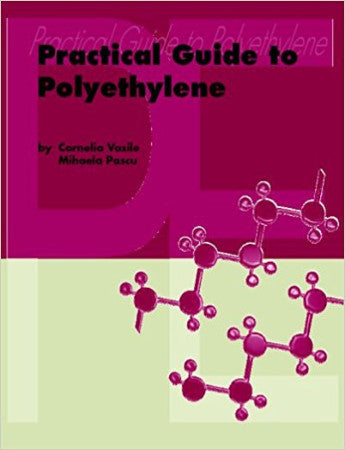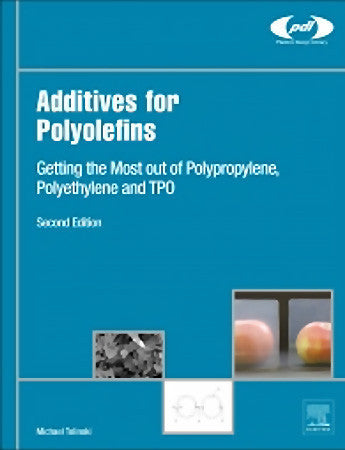Practical Guide to Polyethylene
Polyethylene is probably the most commonly used polymer in everyday life. It is the polymer that is used to make grocery bags, shampoo bottles, children's toys, and even bullet-proof vests. This Practical Guide provides information about every aspect of polyethylene production and uses in a reader-friendly form. It discusses the advantages and disadvantages of working with polyethylene, offering practical comment on the available types of polyethylene, properties and in-service performance, and processing.
The Practical Guide begins with the general background to the polyethylene family, with price, production and market share information. It describes the basic types of polyethylene including virgin & filled polyethylene, copolymers, block and graft polymers and composites, and reviews the types of additives used in polyethylene.Polyethylenes offer a wide range of properties due to differences in structure and molecular weight, and the Practical Guide gives the low down on the properties, including, amongst others, rheological, mechanical, chemical, thermal, and electrical properties.
Design of a polymeric product for a certain application is a complex task, and this is particularly true for polyethylene with its variety of forms and available processing methods. This Practical Guide describes the processing issues and conditions for the wide range of techniques used for polyethylene, and also considers post-processing and assembly issues. It.offers guidance on product design and development issues, including materials selection.
The Practical Guide to Polyethylene is an indispensable resource for everyone working with this material.
The Practical Guide begins with the general background to the polyethylene family, with price, production and market share information. It describes the basic types of polyethylene including virgin & filled polyethylene, copolymers, block and graft polymers and composites, and reviews the types of additives used in polyethylene.Polyethylenes offer a wide range of properties due to differences in structure and molecular weight, and the Practical Guide gives the low down on the properties, including, amongst others, rheological, mechanical, chemical, thermal, and electrical properties.
Design of a polymeric product for a certain application is a complex task, and this is particularly true for polyethylene with its variety of forms and available processing methods. This Practical Guide describes the processing issues and conditions for the wide range of techniques used for polyethylene, and also considers post-processing and assembly issues. It.offers guidance on product design and development issues, including materials selection.
The Practical Guide to Polyethylene is an indispensable resource for everyone working with this material.
1 Introduction
Provides a general introduction to the subject and gives information on price, production and market share.
2 Basic Types
Describes the basic types of PE available including filled PE, copolymers, blocka nd graft polymers and composites.
3 Properties
Gives the low down on the properties of PE. This section includes: density, molecular weight and molecular weight distribution, crystallinity, thermal properties, mechanical properties, electrical properties, optical properties, surface properties, hardness and scratch resistance, abrasion resitaence, friction, acoustic properties, degradation, biological behaviour, biocompatibility, wear, molecular properties, performance in service, permeability, and crosslinking.
4 Additives
Lists information about the types of additives used with PE including: antioxidants, inhibitors, stabilisers, masterbatches, antistatic agents, EMI/radiofrequency shielding, antifogging agents, biocides, blowing agents, biosensitisers, coupling agents, crosslinking agents, flame retardants, fillers/reinforcements/slip and antiblocking agents, metals deactivators, nucleating agents, and pigments and colorants.
5 Rheological Behaviour
Covers rheological behaviour including molar mass effects, steady flow properties, melt flow rates/index, viscosity/shear rate, dynamic rheological properties, chain structure effects and multiphase systems/inhomogenous products.
6 Processing of Polyethylene
Describes processing of PE including, injection moulding, extrusion, blow and stretched moulding, compression moulding, sintering and coating, thermoforming/vacuum forming, rotational moulding, transfer moulding, casting, and recycling and recyclates.
7 Considerations of Product Design and Development
Covers product design and development, including: materials selection, processing techniques, film blowing thermoforming, blow moulding, rotational moulding compression moulding and injection moulding.
8 Post-Processing and Assembly
Covers post processing and assembly. This includes: joining, assembly/fabrication, machining, joints, mechanical fastening, and decorating.
Provides a general introduction to the subject and gives information on price, production and market share.
2 Basic Types
Describes the basic types of PE available including filled PE, copolymers, blocka nd graft polymers and composites.
3 Properties
Gives the low down on the properties of PE. This section includes: density, molecular weight and molecular weight distribution, crystallinity, thermal properties, mechanical properties, electrical properties, optical properties, surface properties, hardness and scratch resistance, abrasion resitaence, friction, acoustic properties, degradation, biological behaviour, biocompatibility, wear, molecular properties, performance in service, permeability, and crosslinking.
4 Additives
Lists information about the types of additives used with PE including: antioxidants, inhibitors, stabilisers, masterbatches, antistatic agents, EMI/radiofrequency shielding, antifogging agents, biocides, blowing agents, biosensitisers, coupling agents, crosslinking agents, flame retardants, fillers/reinforcements/slip and antiblocking agents, metals deactivators, nucleating agents, and pigments and colorants.
5 Rheological Behaviour
Covers rheological behaviour including molar mass effects, steady flow properties, melt flow rates/index, viscosity/shear rate, dynamic rheological properties, chain structure effects and multiphase systems/inhomogenous products.
6 Processing of Polyethylene
Describes processing of PE including, injection moulding, extrusion, blow and stretched moulding, compression moulding, sintering and coating, thermoforming/vacuum forming, rotational moulding, transfer moulding, casting, and recycling and recyclates.
7 Considerations of Product Design and Development
Covers product design and development, including: materials selection, processing techniques, film blowing thermoforming, blow moulding, rotational moulding compression moulding and injection moulding.
8 Post-Processing and Assembly
Covers post processing and assembly. This includes: joining, assembly/fabrication, machining, joints, mechanical fastening, and decorating.
Cornelia Vasile is a senior researcher at the Romanian Academy, ‘P. Poni’ Institute of Macromolecular Chemistry, and Head of Department of Physical Chemistry of Polymers. Cornelia is also an Associate Professor at Laval University - Quebec Canada, at the ‘Gh. Asachi’ Technical University of Iasi and ‘Al. I. Cuza’ University of Iasi. She is the author or co-author of eight books, 300 scientific papers, and holder of 38 patents.




